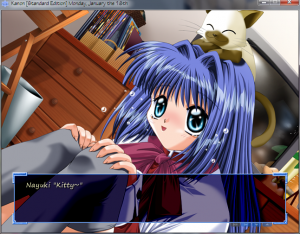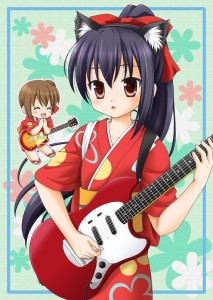What exactly makes an Anime be considered in the Slice of Life genre? There has been talk about it around the blogosphere on the true definition of the Slice of Life genre (Midnight Equinox provides a whole lowdown of bloggers who provided their views on the Slice of Life genre). Like I said in my slightly trollish response, it’s actually complicated. There is a reason why explaining the genre complicated. People have different views on what qualities in the show they would consider as Slice of Life. However, I’m going to share my views on what qualities that would be in the Slice of Life genre.
What is a Slice of Life story?
Before diving in to the gritty details, what is Slice of Life? The dictionary defines it as:
A realistic representation of everyday experience in a movie, play, or book.
Wikipedia defines it a bit further as a:
Slice of Life story portrays a “cut-out” sequence of events in a character’s life. It may or may not contain any plot progress and little character development, and often has no exposition, conflict, or dénouement, with an open ending. It usually tries to depict the everyday life of ordinary people, sometimes but rarely, with fantasy or science fiction elements involved.
It seems simple enough… so, every title out there would be considered a slice of life Anime? That is going too broad. Slice of life stories tend to be very realistic and be related to life and doesn’t contain too much out of the ordinary. The story of this style has to be able to relatable in real life. Therefore, you cannot have shouen fighting scenes, magical girls fighting big monsters or robots fighting each other. If that happened, it wouldn’t be considered a slice of life story since it would not be realistic. However, Slice of Life can contain supernatural or science fiction elements (such as miracles, acts of nature, etc.) as long it feels real or surreal.
Slice of Life as a Genre
Slice of Life is a genre that never stands alone. Slice of Life is a Meta genre that has different genres that support it. The most commonly used genres that associate with the Slice of Life genre are comedy, drama, romance and mystery. A list below shows an example of Anime titles that are in the Slice of Life genre, but have other genres that support it.
- Amagami SS (Romance, Drama, Comedy)
- Angel Beats (Action, Comedy, Drama)
- Aria (Drama, Science Fiction)
- Clannad (Romance, Comedy, Drama, Supernatural)
- Hayate no Gotoku (Action, Comedy, Romance)
- Kaichou wa Maid-sama! (Romance, Shoujo, Drama, Comedy)
- Kanon (Supernatural, Comedy, Drama, Romance)
- Lucky Star (Comedy)
- K-ON! (Comedy, Music)
- Suzumiya Haruhi (Science Fiction, Comedy, Drama, Mystery)
How one defines a show as a Slice of Life story?
As in life, Slice of Life is also inconsistent and development grows slowly compared to regular stories. This is because we do a lot in life such as socializing with people, doing basic needs and other stuff. Character Development is slow since in real life, getting to know a new person takes time. As the title implies, “slice” implies the certain moments in life and does not cover every moment in life. Therefore, you only getting a small picture of someone’s life, but enough to make it feel like you are looking through the character’s life.
How Slice of Life is implemented in Different Mediums?
Although the concept of Slice of Life is the same through the different mediums, they are implemented differently. The ones I will focus are Visual Novels, Anime and Manga.
Visual Novel

Every visual novel out there can be considered in as a Slice of Life since they are mostly split up in days. Notice the day shown on the title bar of the visual novel. Each day is considered a slice of a story and shares a set of events that happens throughout that day. Since the plot is split up in days, plot and character develops as the days goes on consistently.
Also, the choices one makes also affects the development of the story. Because the selections and the story’s format, the visual novel makes the player feel that they are in the main character’s shoes and experiencing every event he/she encounters with different outcomes.
Anime
Since Anime has a set amount of episodes, development of the story can be either consistent or inconsistent. Unlike the visual novel, Slice of Life in Anime only focuses on a certain aspect in the character’s life. For example, in K-ON!! Episode 18, the primarily focus was the school play and the sleepover. Azusa and her classmates focus on the festival activity and see the play. Meanwhile, Mio, Ritsu and Yui get ready for the performance and so on.
Episodes in Slice of Life anime most of the time are fragmented. You will notice that each episode focuses on a different aspect of life. For example, in Lucky Star, each episode is independent of each other and does not mention the previous developments in the last episode.
However, there are some instances that some episodes are continuous depending on the development. For example, Episodes 18 and 19 of K-ON were continuous with each other since it focused on the girls’ preparation on the school play. The continuity in Slice of Life Anime will ultimately depend on the source material itself.
Manga
Although I haven’t read any Manga in the Slice of Life genre, the one I saw frequently is 4Koma. 4Koma always use the Slice of Life storytelling because the 4-panel strip comic only focuses on one situation. 4Koma that eventually gets adapted into Anime will have filter content placed with the original source material to make the show flow better. Compared to Anime and visual novels, 4Koma have very little plot and character development due to the length.
Lastly, Slice of Life ≠ Moe
There is a big misconception out there that Slice of Life shows automatically means girls doing “cute” stuff or characters doing absolutely nothing. The main reason Slice of Life gained this misconception because shows like Azumanga Daioh, Lucky Star and K-ON that are considered to be in the Slice of Life genre had a good amount of “moe.” Since Slice of Life became associated with moe because of the popularity of the mentioned shows, it got a bad reputation among moe haters. In reality, Slice of Life is rarely about moe girls and is more of a story format.
Conclusion
In the end, explaining what makes a show a “pure” Slice of Life is complicated since there is no firm definition. However, I feel that Slice of Life is just a Meta genre that has different genres that helps build the story. On top of that, different mediums implement the Slice of Life story telling differently that there is no unified way of implementing it. The fact remains… Slice of Life has the same qualities of real life, inconsistencies and slow development. It’s something that one should enjoy slowly without worrying about where the plot is going, as in let the story take its course and just enjoy what it has to offer.
If you excuse me, I’m going to eat this slice of yummy strawberry cake.
Attribution Information
Fanart used in this post is made by 美樹めぐり



Slice of Life Anime: An anime genre with no real definition.
Wait. I just blew your mind.
Ka boom!
Well, that pretty much sums it up… and people apparently still debating about it.
If you’re talking about anime which are slice of life and other genre’s, that could be pretty much any anime, but for the the best anime to describe slice-of-life that I’ve seen so far is definitely Aria the Animation.
I don’t think it’s really worth debating in the sense that people who says it isn’t what NovaJinx initially stated probably think any or everything is slice of life.
Speaking of which, there is a hard definition to what it is, it’s just something that very rarely applies to anime.
In the end, Slice of Life is more of a story telling format than a genre that can apply to anything besides Anime, Manga and Visual Novels. Its hard to describe simply because its broad just like life… its simply unpredictable.
Besides, cake tastes better than life… especially strawberry shortcake.